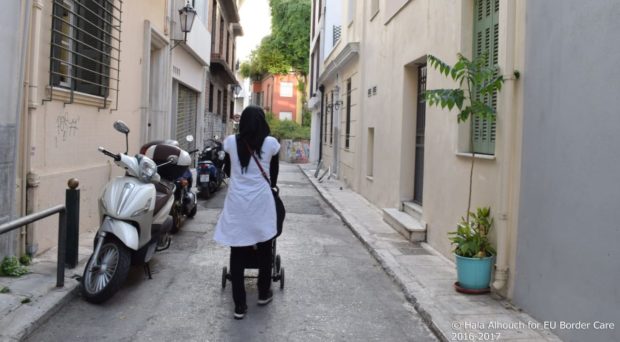
This blog has been cross-posted from the SpringerOpen blog.
The recent diplomatic battle over the ship Aquarius, carrying over 600 migrants rescued from drowning off the Libyan coast in early June 2018 only to be denied disembarkation in both Malta and Italy, is a stark reminder of how, several years into the so-called European crisis of migration, political battles centered on numbers take the focus away from the concrete reality of desperate crossings into southern Europe.
The data we gathered on their daily life and their struggle to continue their journeys document the circumstances that rendered them vulnerable to multiple risks and hardships.
Though pregnant women and children are often showcased in media reports, little is communicated about their personal circumstances and experiences. This was the initial premise of the EU Border Care project funded by the European Research Council, led by Vanessa Grotti.
Over one year, our team of four worked with pregnant migrants at the borders of the European Union on three main Mediterranean routes: the Eastern route through Greece via Turkey, the Central route which crisscrosses sub-Saharan Africa into Italy via Libya, and the western route into Spain via its autonomous enclaves, Melilla and Ceuta, in northern Africa, or alternatively directly into the mainland.
The data we gathered on their daily life and their struggle to continue their journeys document the circumstances that rendered them vulnerable to multiple risks and hardships. Each of these complex, protracted trails carried challenges and hurdles of their own, such as sexual violence and trafficking, lack of access to contraceptives and healthcare, armed conflict and incarceration, but also profound insecurity and lack of ability to control their private and legal existence. This wide range of struggles nevertheless followed clear patterns according to regional dynamics and the demographic composition of migrant cohorts.
“We left a regular war to come to a psychological war … I don’t want to bring a child into the world now and put it through such hardship. I already have two children going through this; it’s enough.” (Hajer, November 2016)
The reflections above were given by Hajer, a 30-year-old Syrian refugee from Aleppo. Hajer arrived in Athens from Turkey via the island of Lesvos in March 2016. Her family’s application to transfer their asylum claim to another EU member state was rejected, and they are now still trying to find other routes out of Greece. In the past two years, Hajer has had to pack her family’s belongings and rebuild a temporary home in the Greek capital city seven times.

After a perilous trail through their war-torn country, a brief sojourn in Turkey which often included jail time, and a near-deadly sea crossing into Greece, the Syrian women that we spoke to had envisioned a quick crossing through Greece and on to countries of northern and western Europe, where, in many cases, their extended families were already settled. Yet the closing of the Balkan route in 2016 trapped them in Athens, forcing them to navigate an obscure and obstructive bureaucratic process of transition to another European country.
The pregnant women in the Spanish enclave of Melilla felt similarly trapped. Upon arrival, migrants were put up in the Centre for the Temporary Stay of Immigrants, awaiting police authorization to be transferred to the Spanish “peninsula”. Living in cramped facilities, neither designed for longer stays nor adapted to host families and babies, Hanae, a 30-year-old Algerian woman with a six-week-old baby, found herself isolated and without help.
“There is no support, it’s difficult to take care of a baby alone, I need some help from people, to wash clothes, if I want to go to the toilets I’ll find the baby crying…it’s very difficult after the birth there is a lot of pain, you’re always tired, you can’t even go to drink a glass of water or eat a fruit.” (Hanae, September 2016)
But while protracted bureaucracy and inappropriate accommodation in overcrowded camps, freezing containers and alienating detention centers in Spain and Greece increased women’s vulnerability to sexual violence and harassment, testing their resilience and determination away from familiar relations and support networks, it was conflict and lawlessness that impacted women on the central Mediterranean migration route most.
The central message that we hope for our work to impart is that vulnerability does not equate to victimhood.
Italy lies at the receiving end of the deadliest crossing in the world, where the context of reception is marked by emergency: the emergency of search and rescue operations at sea, and the specific forms of medical and social care that treat pregnant women who travel along that route.
Our paper discusses at length the specific forms of violence that affect women along this migration trail which originates in western Africa and in the Horn of Africa. The women we spoke to were often extremely young and had been victim of trafficking networks at an early age, thus bearing reproductive health complications resulting from extensive periods of abuse and lack of medical care.
Our research demonstrates that the factors that rendered pregnant migrants vulnerable overlap but also differ among our Mediterranean field sites. The central message that we hope for our work to impart is that vulnerability does not equate to victimhood. The women with whom we worked fought against their circumstances with a determination often belied by their media portrayals.
Further, vulnerability and hardship are not natural phenomena or by any means necessary features of borderlands. If suitable structures and networks of support are put in place – notably forms of legal and safe passage – many of the harrowing experiences we have described here could be avoided.
Comments